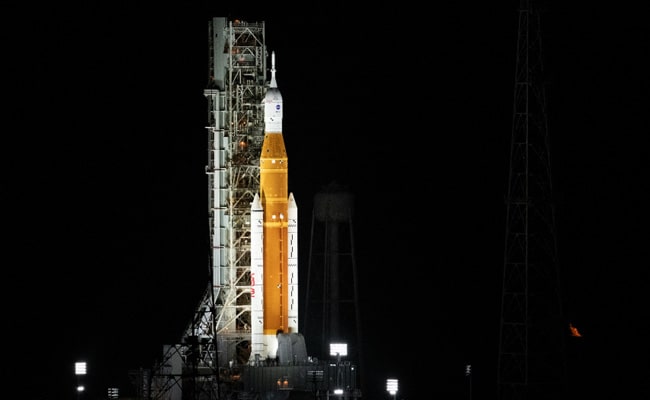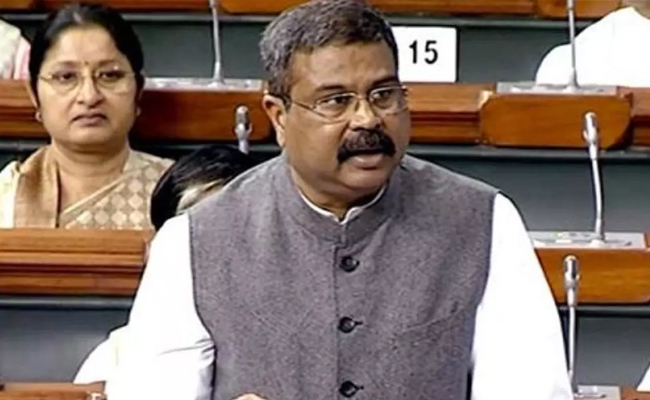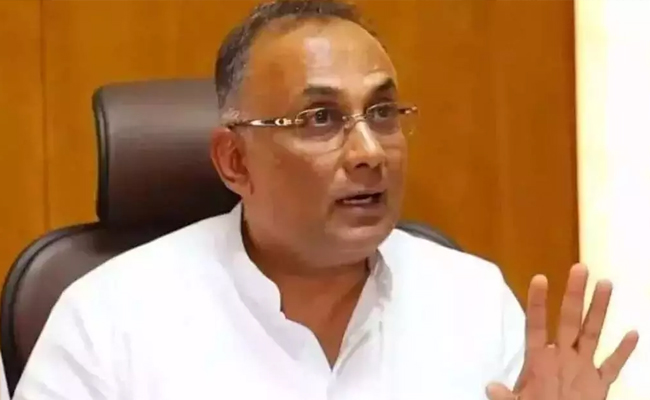Cape Canaveral, Aug 29: Fuel leaks during final liftoff preparations threatened to postpone the launch of NASA's mighty new moon rocket Monday morning on its shakedown flight with three test dummies aboard.
As precious minutes ticked away, NASA repeatedly stopped and started the fuelling of the Space Launch System rocket with nearly 1 million gallons of super-cold hydrogen and oxygen because of a leak.
The fuelling already was running nearly an hour late because of thunderstorms off Florida's Kennedy Space Centre.
The leak of highly explosive hydrogen appeared in the same place that saw seepage during a dress rehearsal back in the spring.
Then a second apparent hydrogen leak turned up in a valve that had caused trouble in June but that NASA thought it had fixed, officials said.
Later in the morning, NASA officials spotted what they feared was a crack or some other defect on the core stage the big orange fuel tank with four main engines on it but they later said it appeared to be just a buildup of frost.
The rocket was set to lift off on a mission to put a crew capsule into orbit around the moon.
The launch represents a milestone in America's quest to put astronauts back on the lunar surface for the first time since the Apollo programme ended 50 years ago.
NASA's assistant launch director, Jeremy Graeber, said after the repeated struggles with the first leak that the space agency would have to decide whether to go forward with the Monday morning launch.
"We have a lot of work to get to that point," Graeber cautioned.
If NASA scrubbed Monday's launch, the next attempt wouldn't be until Friday at the earliest.
The 322-foot spaceship is the most powerful rocket ever built by NASA, out-muscling even the Saturn V that took the Apollo astronauts to the moon.
No astronauts were inside the rocket's Orion capsule.
Instead, the test dummies, fitted with sensors to measure vibration, cosmic radiation and other conditions, were strapped in for the six-week mission, scheduled to end with the capsule's splashdown in the Pacific in October.
Even though no one was on board, thousands of people jammed the coast to see the rocket soar.
Vice President Kamala Harris was expected among the VIPs.
The launch is the first flight in NASA's 21st-century moon-exploration programme, named Artemis after Apollo's mythological twin sister.
Assuming the test goes well, astronauts will climb aboard for the second flight and fly around the moon and back as soon as 2024.
A two-person lunar landing could follow by the end of 2025.
The problems seen Monday were reminiscent of NASA's space shuttle era, when hydrogen fuel leaks disrupted countdowns and delayed a string of launches back in 1990.
Launch director Charlie Blackwell-Thompson and her team also had to deal with a communication problem involving the Orion capsule.
Engineers scrambled to understand an 11-minute delay in the communication lines between launch control and Orion that cropped up late Sunday.
Though the problem had cleared by Monday morning, NASA needed to know why it happened before committing to a launch.
Let the Truth be known. If you read VB and like VB, please be a VB Supporter and Help us deliver the Truth to one and all.
New Delhi: A bill to set up a 13-member body to regulate institutions of higher education was introduced in the Lok Sabha on Monday.
Union Education Minister Dharmendra Pradhan introduced the Viksit Bharat Shiksha Adhishthan Bill, which seeks to establish an overarching higher education commission along with three councils for regulation, accreditation, and ensuring academic standards for universities and higher education institutions in India.
Meanwhile, the move drew strong opposition, with members warning that it could weaken institutional autonomy and result in excessive centralisation of higher education in India.
The Viksit Bharat Shiksha Adhishthan Bill, 2025, earlier known as the Higher Education Council of India (HECI) Bill, has been introduced in line with the National Education Policy (NEP) 2020.
The proposed legislation seeks to merge three existing regulatory bodies, the University Grants Commission (UGC), the All India Council for Technical Education (AICTE), and the National Council for Teacher Education (NCTE), into a single unified body called the Viksit Bharat Shiksha Adhishthan.
At present, the UGC regulates non-technical higher education institutions, the AICTE oversees technical education, and the NCTE governs teacher education in India.
Under the proposed framework, the new commission will function through three separate councils responsible for regulation, accreditation, and the maintenance of academic standards across universities and higher education institutions in the country.
According to the Bill, the present challenges faced by higher educational institutions due to the multiplicity of regulators having non-harmonised regulatory approval protocols will be done away with.
The higher education commission, which will be headed by a chairperson appointed by the President of India, will cover all central universities and colleges under it, institutes of national importance functioning under the administrative purview of the Ministry of Education, including IITs, NITs, IISc, IISERs, IIMs, and IIITs.
At present, IITs and IIMs are not regulated by the University Grants Commission (UGC).
Government to refer bill to JPC; Oppn slams it
The government has expressed its willingness to refer it to a joint committee after several members of the Lok Sabha expressed strong opposition to the Bill, stating that they were not given time to study its provisions.
Responding to the opposition, Parliamentary Affairs Minister Kiren Rijiju said the government intends to refer the Bill to a Joint Parliamentary Committee (JPC) for detailed examination.
Congress Lok Sabha MP Manish Tewari warned that the Bill could result in “excessive centralisation” of higher education. He argued that the proposed law violates the constitutional division of legislative powers between the Union and the states.
According to him, the Bill goes beyond setting academic standards and intrudes into areas such as administration, affiliation, and the establishment and closure of university campuses. These matters, he said, fall under Entry 25 of the Concurrent List and Entry 32 of the State List, which cover the incorporation and regulation of state universities.
Tewari further stated that the Bill suffers from “excessive delegation of legislative power” to the proposed commission. He pointed out that crucial aspects such as accreditation frameworks, degree-granting powers, penalties, institutional autonomy, and even the supersession of institutions are left to be decided through rules, regulations, and executive directions. He argued that this amounts to a violation of established constitutional principles governing delegated legislation.
Under the Bill, the regulatory council will have the power to impose heavy penalties on higher education institutions for violating provisions of the Act or related rules. Penalties range from ₹10 lakh to ₹75 lakh for repeated violations, while establishing an institution without approval from the commission or the state government could attract a fine of up to ₹2 crore.
Concerns were also raised by members from southern states over the Hindi nomenclature of the Bill. N.K. Premachandran, an MP from the Revolutionary Socialist Party representing Kollam in Kerala, said even the name of the Bill was difficult to pronounce.
He pointed out that under Article 348 of the Constitution, the text of any Bill introduced in Parliament must be in English unless Parliament decides otherwise.
DMK MP T.M. Selvaganapathy also criticised the government for naming laws and schemes only in Hindi. He said the Constitution clearly mandates that the nomenclature of a Bill should be in English so that citizens across the country can understand its intent.
Congress MP S. Jothimani from Tamil Nadu’s Karur constituency described the Bill as another attempt to impose Hindi and termed it “an attack on federalism.”



_vb_22.jpeg)

